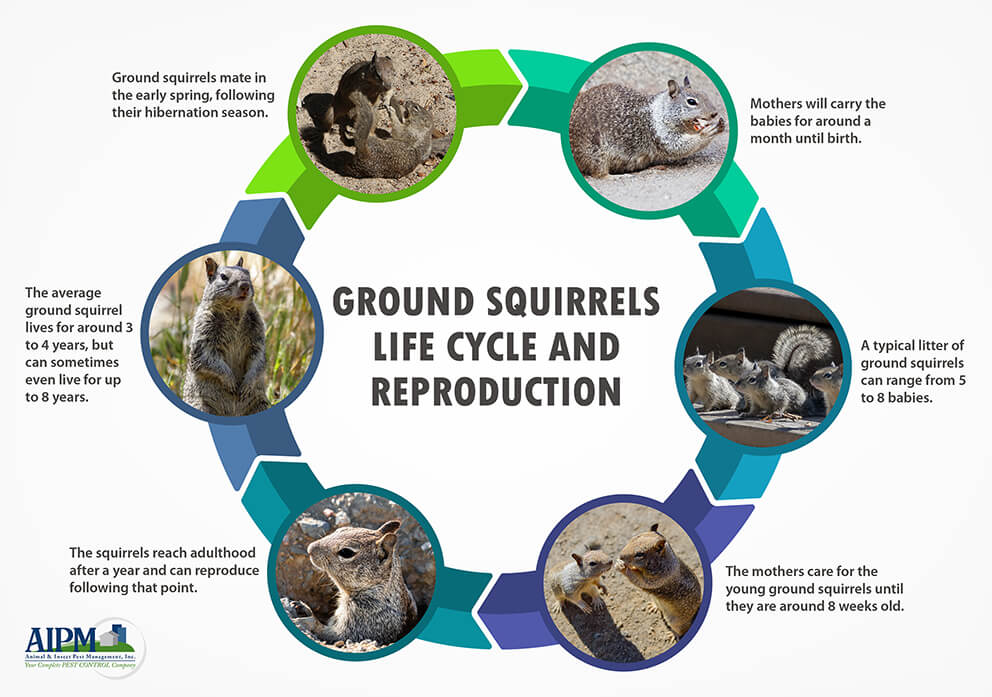Troublesome, destructive, and common all throughout California, ground squirrels can be a pesky pest to deal with. Learn all about the lifecycle, behavior, and features of a ground squirrel, plus, effective forms of ground squirrel pest control, by reading here.
Ground Squirrel Appearance
Ground squirrels are brown, beige, or a combination of the two in color. Their belly can generally be a lighter color than the top of the fur. Males can be larger than females; however, most squirrels are around 15 inches long and 25 ounces. Their tails are quite bushy and overall, they closely resemble tree squirrels. Despite being able to climb, ground squirrels prefer burrowing, especially when startled.
How Do Ground Squirrels Damage My Property
Ground squirrels may be small but they can cause a lot of damage. These pests burrow under the ground and can destroy carefully constructed landscaping, as well as chew through underground wires and other structural elements, such as sprinkler heads. They enjoy a wide variety of food, so no vegetable garden or appealing vegetation is safe from ground squirrel populations. Beyond the physical damage, ground squirrels can transmit harmful diseases. Do not touch ground squirrels and be wary of pets that attempt to interact with them.
Types of Ground Squirrels
Ground squirrels often go by many names, including marmots, chipmunks, or prairie dogs; however, there are only two species of closely related ground squirrels located in the California region. Generally, they are considered so similar that they are more or less considered the same species and simply referred to as the California ground squirrel.
Ground squirrels live in areas where the winter is mild and prefer open, grassy areas. They can invade residential areas and cause large amounts of destruction when burrowing and chewing.
Life Cycle and Reproduction
 Ground squirrels mate in the early spring, following their hibernation season. Mothers will carry the babies for around a month until birth. A typical litter of ground squirrels can range from 5 to 8 babies, or kits. The mothers care for the young ground squirrels until they are around 8 weeks old. The squirrels reach adulthood after a year and can reproduce following that point. The average ground squirrel lives for around 3 to 4 years, but can sometimes live for up to 8 years!
Ground squirrels mate in the early spring, following their hibernation season. Mothers will carry the babies for around a month until birth. A typical litter of ground squirrels can range from 5 to 8 babies, or kits. The mothers care for the young ground squirrels until they are around 8 weeks old. The squirrels reach adulthood after a year and can reproduce following that point. The average ground squirrel lives for around 3 to 4 years, but can sometimes live for up to 8 years!
Behavior and Diet
Ground squirrels live in communities of interconnected burrows. Inside these burrows, the ground squirrels east, sleep, care for the young, and hide from danger. Some burrows can be up to 30 feet long and 2-3 feet beneath the surface of the ground. Other burrows can be deeper and branch out beneath the earth. They’re mainly active during the day, especially on warm, bright days. Most ground squirrels will hibernate in winter, although that is not always the case.
In terms of food, most ground squirrels eat a variety of things. Their diet changes depending upon what is available in the season. Green grass and herbaceous plants are ground squirrel favorites, as are seeds, nuts, and grains. Vegetables growing in a garden can also be consumed by hungry ground squirrels.
Ground Squirrel Control
While ground squirrels can be alarming to see on your property, don’t worry! There are a variety of different methods of removing ground squirrels that are noninvasive and effective. Some can be attempted DIY while others require professional assistance in order to ensure safe results.
Baiting
Lacing ground squirrel food sources with chemicals, especially during the spring or summer, can remove a large portion of the ground squirrel population from your property. However, when using pesticides, it’s best to use professional help. Improperly applied pesticides can harm other members of the natural ecosystem, including humans and pets.
Trapping
Trapping is both practical and effective, but only for properties with a smaller ground squirrel population size. These traps capture ground squirrels, which can later be safely released. Live traps require the relocation of animals after catching, whereas kill traps can be unsightly around your property.
CO2 Machines
This method of pest control is effective and more humane than pesticide usage. By applying CO2 directly into burrows, entire populations of ground squirrels can be effectively removed. Be sure to tackle all ground squirrel burrows on your property when using a CO2 machine. This method also removes the need for disposal after application.
Take immediate action as soon as you spot ground squirrel activity throughout your property to avoid any damage. By partnering with a professional pest control company, you can return your home to its usual good condition while ensuring that the pest problem is effectively taken care of. Learn more here about AIPM’s range of pest control methods, including those for ground squirrels!
